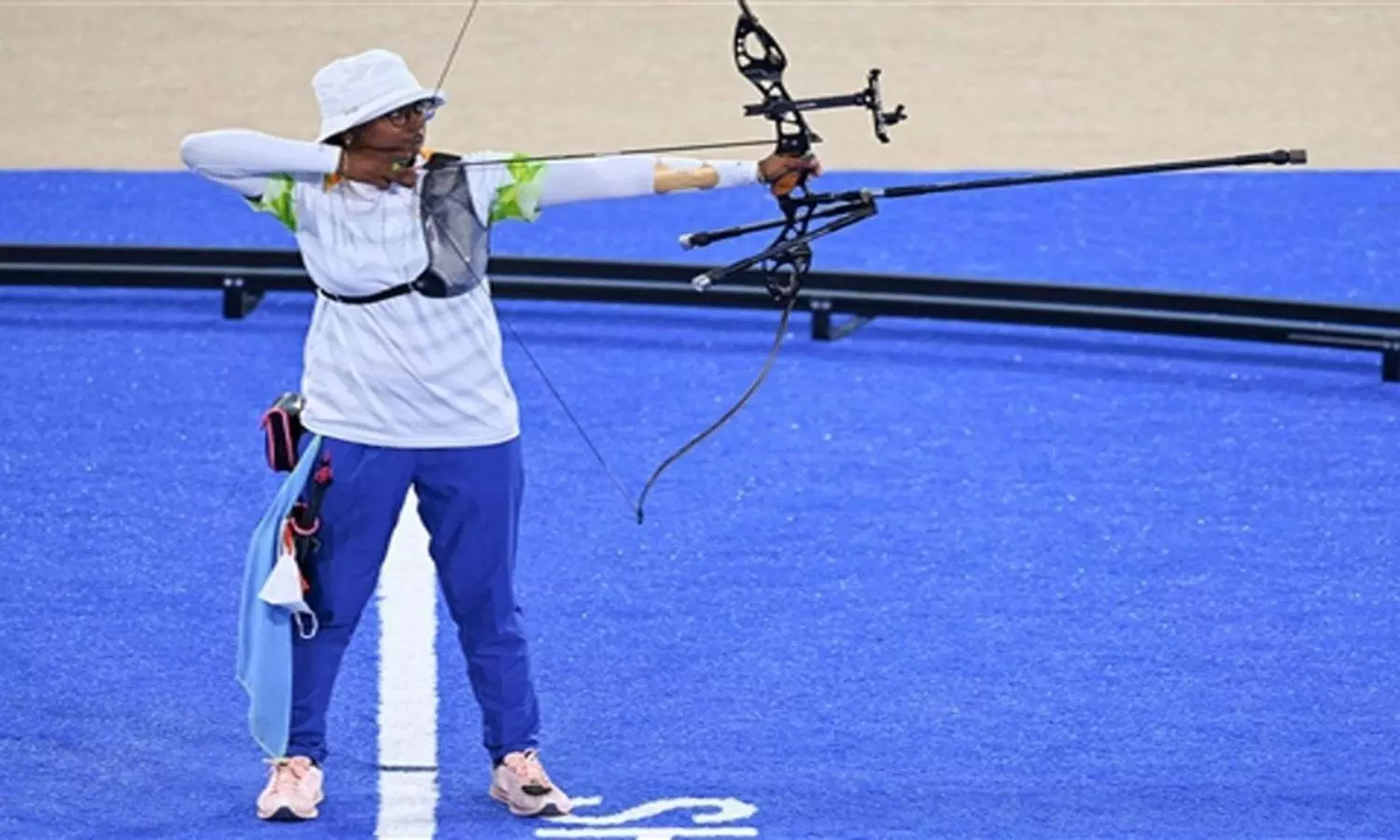Archery
What is wrong with Indian Archery?
At the Paris Olympics, there was promise on offer but the archers produced a damp squib.

A quarter-final finish was all that Deepika Kumar could managed at the Paris Olympics. (File photo)
4, 6, 7.
These are numbers that hold much significance for Indian archery as these numbers translated to another dismal campaign of the Indian recurve archers at the Olympics in Paris.
It has become a trend of sorts now - the Indian archers head the Olympics with hopes and aspirations and return home empty handed.
More than the lack of a medal, the absence of a fight hurts as the Indian archers are unable to handle the tough situation, often shooting 4s and 6s to end up second best.
"Aim for the moon, If you miss, you may hit a star," is a phrase often used to motivate people but in a sport like archery, you don't need to aim for the moon, you have just hit the target which Indian archers are unable to do at the moment.
There has been a huge hue and cry about the fact that Indian recurve archers have made little progress over the years while compound archers have been conquering the world.
The current problem of Indian archers failing at the highest level and no pipeline of promising archers coming up is systematic and has several layers of underlying problems.
Drama before Olympics
The drama around archery started even before the Olympics began when Korean coach Woong Ki was denied accreditation for the Paris Olympics and was sent back to India.
Instead, former Indian archer Purnima Mahato was preferred over a foreign expert who delivered two gold medals in the 2012 London Olympics for Korea.
Brought in to sharpen the skills of Indian archers and prepare them for Paris, Woong Ki was left fuming after the decision and is in no mood to renew the contract that expires on the 30th of August.
“I have been training them (Indian archers) for two years to win a medal at the Paris Olympics. However, foreign coaches were excluded due to the IOA’s poor and hasty administration. I don’t know why they invested money to appoint a Korean coach. More importantly, it’s hitting a major notch just days before the Olympics," Woong Ki said after his ouster.
"Psychological pressure plays a huge part in the Olympics. Coaches are there to help archers navigate through such situations. My two years of hard work of training the archers is wasted due to these petty things," Woong Ki said.
Whether it is the fault of the Indian Olympic Association or the Archery Association of India, Woong's statement about the psychological pressure proved to be true with Indian the archers faltering in the crucial situation.
Lack of coaching exposure and misguidance
Coaching is one of the bones of contention for Indian archery for ages, especially in recurve.
While good coaches have emerged in the compound archery, recurve archers are still stuck with old coaches and no new approach on offer to improve their temperament.
"There is no exposure for coaches and there is no innovation. The guidance from coaches doesn't exist much at the grassroots level. When you don't focus on grassroots, things tend to go haywire," former recurve archer, coach, and sports broadcaster Pankaj Athwale told The Bridge over a phone call.
The point of lack of innovation was evident during the dismal campaign of the Indian archers at the 2024 Paris Olympics.
To put it in context, the individual events have a shot clock of 20 seconds for every shot. If the archer doesn't shoot in those 20 seconds, they are awarded 0 points.
Indian women archers, especially the experienced Deepika Kumari, shot most of her arrows in the last five seconds resulting in wayward shots. The same approach resulted in the women's team shooting as low as 4 in the team event.
Despite the approach failing multiple times in the first round and team events, there was no change of approach which displays a clear lack of innovation.
Focus on immediate results instead of developing a process
"One of the biggest problems of Indian archery is that people focus on results and try to win as many rewards as possible, i.e. government jobs. If everybody is short-sighted, there is no way we will achieve excellence," said Pankaj.
The point made about being short-sighted is valid as the Indian recurve archers have won medals only at the World Cups and not the World Championships which is a high-pressure event.
India's last world championships medal came way back in 2019 in the men's team and they have nothing to show for in this Olympic cycle.
Another problem that Pankaj explained is about the accountability of the stakeholders and how things are done in the Indian archery fraternity. There is nothing done to counter the problem of archers moving towards compound more because of the supposed ease of compound archery.
"Between Compound and Recurve, compound is the easy one and promising archers are just taking up compound archery. There is nothing done to focus on the pipeline of the next generation of the archers. I believe it is the responsibility of the stakeholders of the ecosystem," explained Pankaj.
Long and arduous road ahead
Despite a horror campaign, not all is lost for the Indian archers as Dhiraj Bommadevara showed promise on his debut at the Olympics and Deepika Kumari rode her luck to the quarter-finals.
The pairing of Dhiraj and Ankit Bhakat also made it to the medal match in the mixed team category.
The key from here is to build on the existing talent and make them more equipped to handle tough situations and condition them mentally.
Another important issue to be addressed by stakeholders of archery is the lack of a pipeline of Indian archers for the recurve event. Barring Dhiraj in men's recurve and, Ankita and Bhajan in women's recurve, there are hardly any archers that can shine at the moment on the world stage.
Archery can take a cue from Shooting where the Indian marksmen have bounced back from the two consecutive medal-less Olympic campaigns (2016 Rio and 2020 Tokyo) and have now returned home with three medals.
After the debacle at the Tokyo Olympics, the Indian shooters won 21 quotas for the Paris Olympics, and only three shooters made it to the squad for Paris, a fact that highlights the the depth of Indian shooting.
The Archery Association of India (AAI) can do well to take a leaf out of the work put in by The National Rifle Association of India (NRAI) of creating high-pressure situations like World Championships and shooters practicing it.
The task, however, is herculean in nature.
With no overnight solutions in the offing, the road ahead for recurve archery in India is long and arduous.

